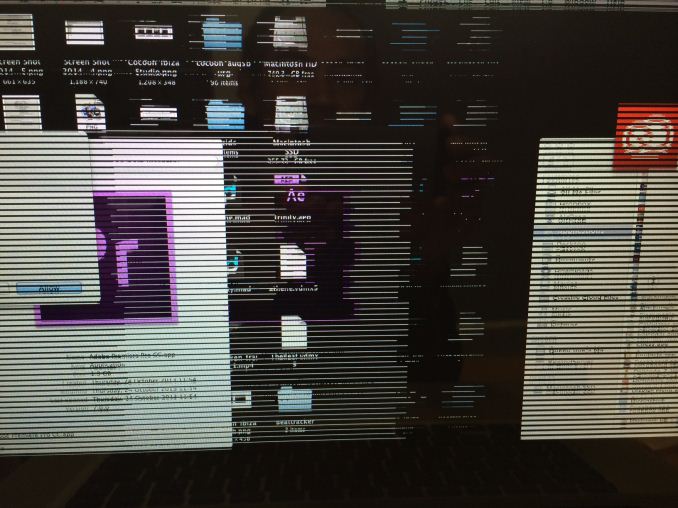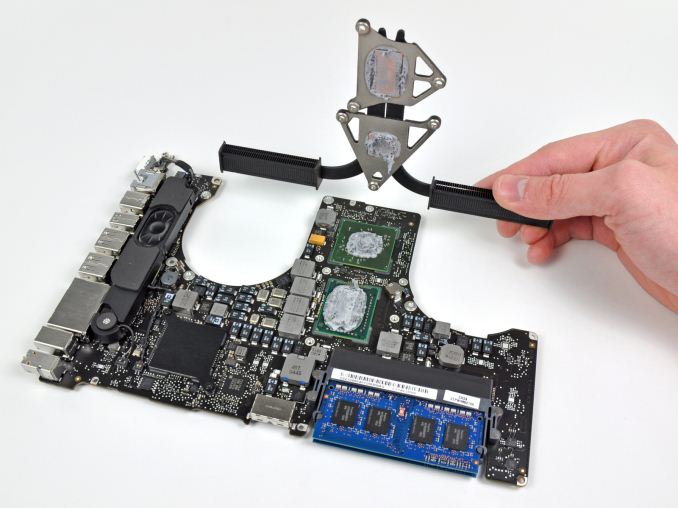Apple Initiates Video Repair Program for 2011-2013 MacBook Pros
by Ryan Smith on February 20, 2015 8:00 AM EST- Posted in
- GPUs
- AMD
- Apple
- MacBook Pro
- NVIDIA

This week Apple has announced that they are initiating a new repair extension program for the MacBook Pro, in order to address video corruption and stability problems with certain models. The program offers extended repair service for the 15” and 17” 2011 MacBook Pros, along with the 2012 and Early 2013 15” Retina MacBook Pros.
Under the terms of the program, covered laptops that are experiencing video issues such as display corruption, system crashes, or other glitches will be eligible for free repairs through Apple. Furthermore all affected systems are eligible regardless of warranty status, making this a true extension in every sense of the word as the bulk of the systems this program covers are past their extended warranty expiration dates. Meanwhile in order to compensate any users who have already suffered from the issue, Apple is also offering reimbursements to those customers who have already paid for repairs.

MacBook Pro Display Corruption (Image Courtesy 9to5Mac)
The MacBook Pro repair program comes less than 2 years after Apple’s last repair program, which in 2013 saw Apple offering free video card replacements and repairs for the mid-2011 27” iMac. And given the similarities between the problems in the MacBook Pro and the iMac, this has raised a few eyebrows. While the 2011 iMac and MacBook Pros use different GPUs, both systems use GPUs from AMD’s Radeon HD 6000M series, with the iMac using the higher-end 6970M while the MacBook Pros used the 6490M, 6750M, and 6770M GPUs.
However throwing a wrench into any common thread between these systems, the last of the MacBook Pros covered by the repair program, the first generation 15” Retina MacBook Pros, used NVIDIA’s GeForce GT 650M instead. There is also the matter of differences in construction – iMacs used MXM cards, MacBook Pros use GPUs soldered on to the logic board – and even differences in operation. Namely, while the iMac used its dGPU exclusively the MacBook Pros all used switchable graphics, which means that the MacBook Pros are often being driven by their iGPU rather than their dGPU.

Early 2011 15" MacBook Pro: CPU & GPU Cooling; the GPU is the topmost chip (Image Courtesy iFixit)
Consequently while we first suspected that this is a common issue revolving around the Radeon HD 6000M series – and certainly we can’t rule that out – there seems to be more that’s going on here than a common failure in one line of GPUs. This could include Apple opting to address multiple modes of failure under a single repair program, or even just pure coincidence. At the same time we haven’t seen a widespread repair program issued by other OEMs for any of these GPUs, which may mean that Apple is the only OEM being seriously affected, unlike NVIDIA’s bumpgate which saw repair programs from a number of OEMs.
For that reason I find myself wondering whether another factor such as cooling has been playing a role here. Although these Apple devices all use different coolers, one common element in Apple’s iMac and Retina MacBook Pro designs has been the comapny's aggressiveness in controlling the thickness of those devices, leading to them pushing the envelope on cooling relatively high TDP processors in tight spaces.
In any case, the full details of the program, including the affected models and repair instructions, are available over at Apple’s website.
Source: 9to5Mac










59 Comments
View All Comments
tipoo - Friday, February 20, 2015 - link
It's good that they finally got around to this, but completely scummy that they waited 4 years by which time most people would have moved on.I think this problem was with the BGA under the GPU, the lead free solder cracking under repeated heat cycles. I think my 2009 Dell Studio 15 is dying a similar death, only turns on when I leave it in a limbo state to get really hot.
tipoo - Friday, February 20, 2015 - link
Also I wish Apple put a little more into cooling, even to this date. My new Haswell rMBP 15" runs at up to 99 degrees Celsius under load, while tJunction max for Haswell is only 100. That's worrying. It's under the Intel reccomended point for now, but only just - what happens in the summer, or in a few years when there's dust in the vents?http://ark.intel.com/products/83505/Intel-Core-i7-...
Flunk - Friday, February 20, 2015 - link
You know the answer to that, it will throttle the frequency into the ground. This is a common problem with Apple's higher-end stuff.Maltz - Friday, February 20, 2015 - link
If it's running that close to the line, it's probably already throttling.tipoo - Friday, February 20, 2015 - link
I keep an eye on the frequencies, and no it isn't. The GPU is always at the highest turbo, the CPU mostly is, and the odd time it does scale back is only to the base clock anyways, not throttling down past that.WinterCharm - Friday, February 20, 2015 - link
Anandtech's review of the rMBP says that it's able to run at max temps under max load WITHOUT throttling :) Now, you will definitely want to keep the vents clean, though :)tipoo - Friday, February 20, 2015 - link
That's true, mine does not throttle, but I always found Anandtechs max temperature test lacking on that. Just going off memory, they used Half Life 2 to hit 78C? That's not a good enough load, mine hits 99C as I said on modern games. HL2 was old even when that article came out (they only tested the Ivy Bridge one, which probably could have run hotter than the Haswell).tipoo - Friday, February 20, 2015 - link
Here it was, max GPU temp was actually 72 in that test. Not a realistic absolute max, especially as IVB would have run hotter than Haswellhttp://www.anandtech.com/show/6023/the-nextgen-mac...
FelixDraconis - Friday, February 20, 2015 - link
My 15" Retina at work is starting to randomly freeze. We stuck it up on a laptop shelf and it's stopped crashing for now.Was great for two and a half years. Now probably choking on heat.
Samus - Friday, February 20, 2015 - link
I very rarely see any apple pc last more than 5 years, especially notebooks. Compared to thinkpad's and elitebook's that last a decade and meet military MIL-STD-810G spec's...I think people who buy apple hardware are simply misinformed.I fix more Macbook motherboards than all other PCB reflows combined.